Taiwanese vs Black/African American Community Comparison
COMPARE
Taiwanese
Black/African American
Social Comparison
Social Comparison
Taiwanese
Blacks/African Americans
6,532
SOCIAL INDEX
62.8/ 100
SOCIAL RATING
151st/ 347
SOCIAL RANK
688
SOCIAL INDEX
4.4/ 100
SOCIAL RATING
338th/ 347
SOCIAL RANK
Black/African American Integration in Taiwanese Communities
The statistical analysis conducted on geographies consisting of 31,675,188 people shows no correlation between the proportion of Blacks/African Americans within Taiwanese communities in the United States with a correlation coefficient (R) of 0.012. On average, for every 1% (one percent) increase in Taiwanese within a typical geography, there is an increase of 0.341% in Blacks/African Americans. To illustrate, in a geography comprising of 100,000 individuals, a rise of 1,000 Taiwanese corresponds to an increase of 340.7 Blacks/African Americans.
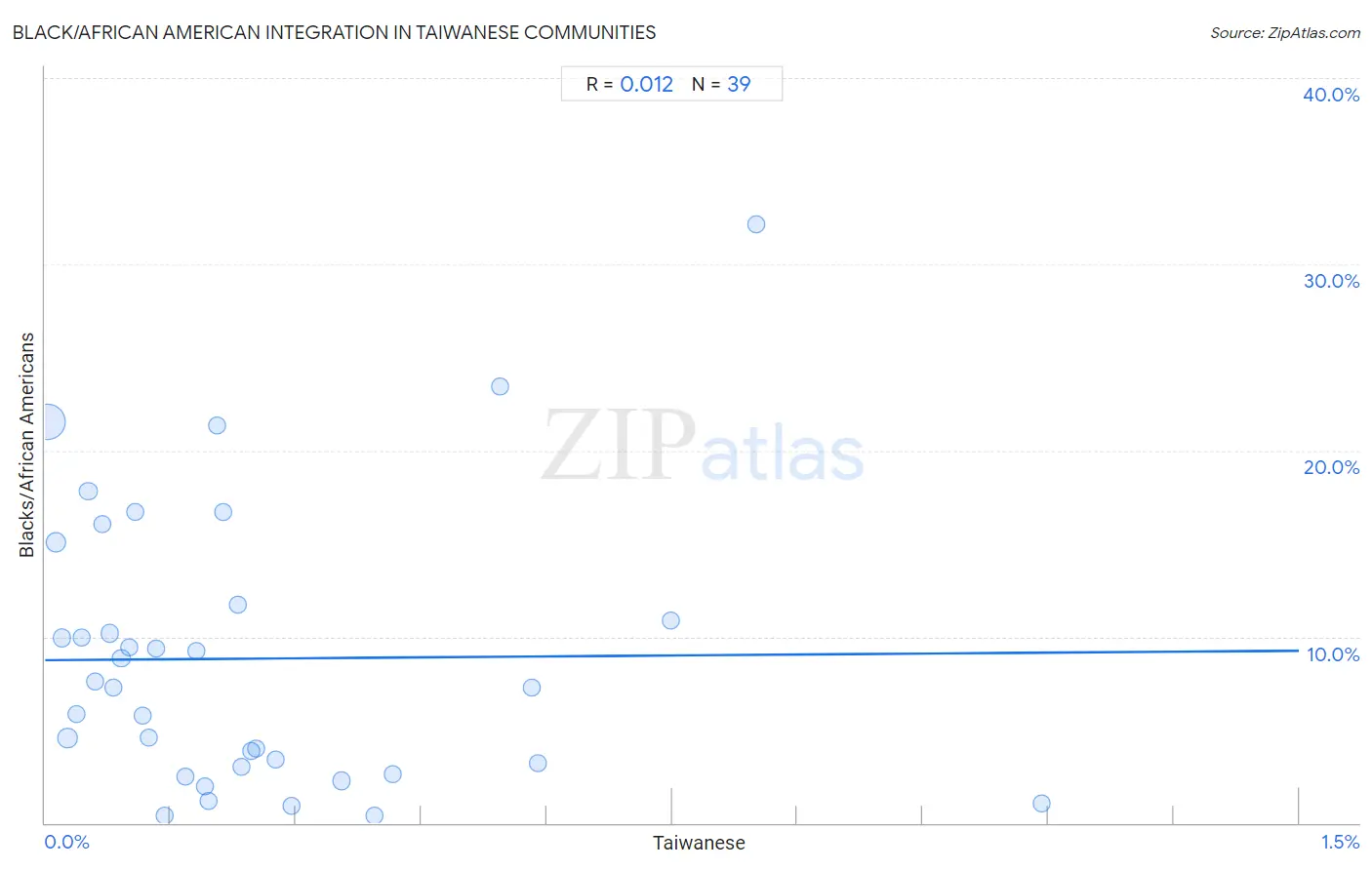
Taiwanese vs Black/African American Income
When considering income, the most significant differences between Taiwanese and Black/African American communities in the United States are seen in householder income ages 25 - 44 years ($101,492 compared to $73,370, a difference of 38.3%), median household income ($89,900 compared to $67,573, a difference of 33.0%), and householder income ages 45 - 64 years ($104,180 compared to $78,556, a difference of 32.6%). Conversely, both communities are more comparable in terms of householder income under 25 years ($49,804 compared to $44,381, a difference of 12.2%), median female earnings ($40,576 compared to $35,315, a difference of 14.9%), and wage/income gap (25.1% compared to 21.7%, a difference of 15.7%).

| Income Metric | Taiwanese | Black/African American |
| Per Capita Income | Exceptional $46,455 | Tragic $35,564 |
| Median Family Income | Exceptional $107,295 | Tragic $81,912 |
| Median Household Income | Exceptional $89,900 | Tragic $67,573 |
| Median Earnings | Excellent $47,902 | Tragic $40,085 |
| Median Male Earnings | Good $55,556 | Tragic $45,523 |
| Median Female Earnings | Excellent $40,576 | Tragic $35,315 |
| Householder Age | Under 25 years | Tragic $49,804 | Tragic $44,381 |
| Householder Age | 25 - 44 years | Exceptional $101,492 | Tragic $73,370 |
| Householder Age | 45 - 64 years | Excellent $104,180 | Tragic $78,556 |
| Householder Age | Over 65 years | Excellent $62,894 | Tragic $50,779 |
| Wage/Income Gap | Excellent 25.1% | Exceptional 21.7% |
Taiwanese vs Black/African American Poverty
When considering poverty, the most significant differences between Taiwanese and Black/African American communities in the United States are seen in child poverty under the age of 5 (14.5% compared to 25.7%, a difference of 77.3%), child poverty among girls under 16 (14.6% compared to 24.7%, a difference of 68.6%), and child poverty under the age of 16 (14.5% compared to 24.4%, a difference of 68.5%). Conversely, both communities are more comparable in terms of female poverty among 18-24 year olds (21.2% compared to 24.3%, a difference of 14.4%), seniors poverty over the age of 75 (12.6% compared to 14.6%, a difference of 16.5%), and seniors poverty over the age of 65 (11.2% compared to 13.7%, a difference of 22.9%).
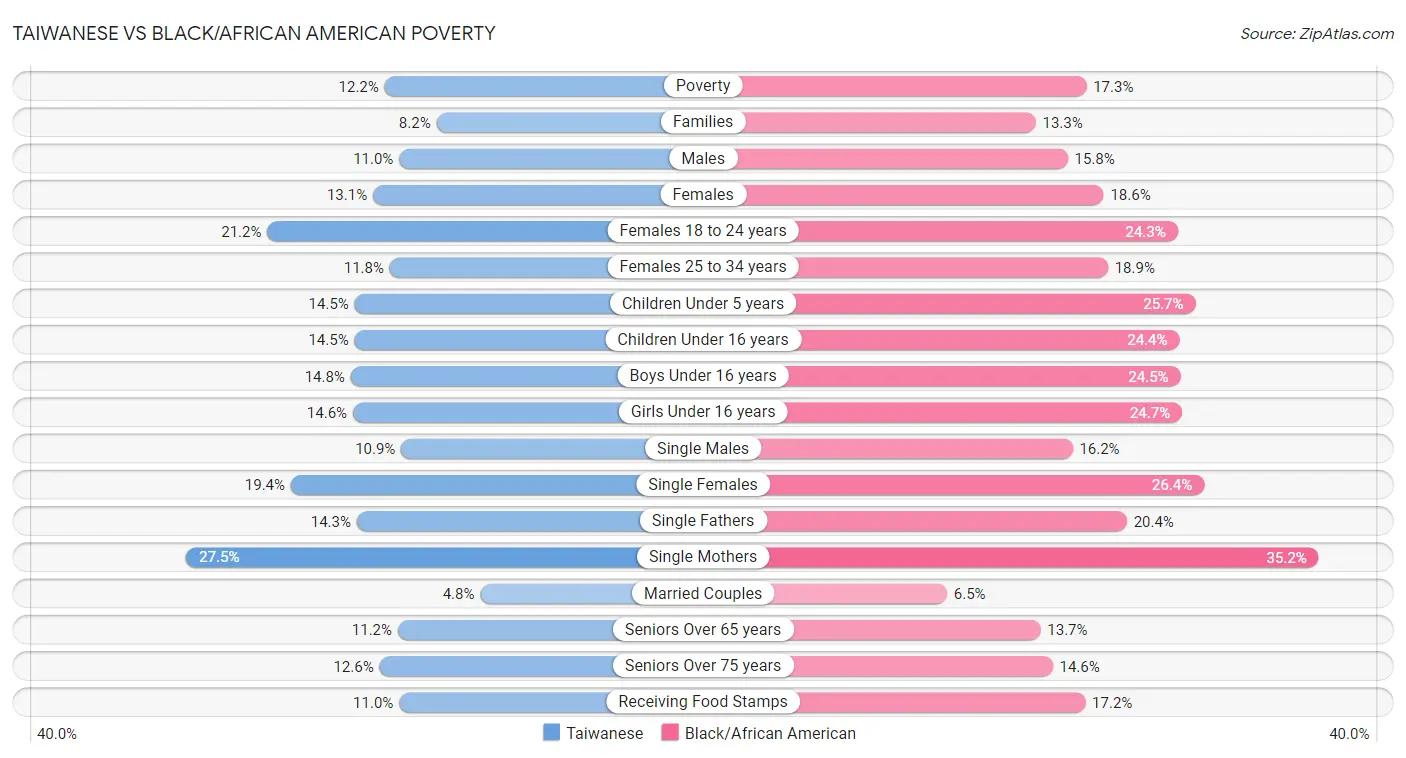
| Poverty Metric | Taiwanese | Black/African American |
| Poverty | Good 12.2% | Tragic 17.3% |
| Families | Exceptional 8.2% | Tragic 13.3% |
| Males | Good 11.0% | Tragic 15.8% |
| Females | Good 13.1% | Tragic 18.6% |
| Females 18 to 24 years | Tragic 21.2% | Tragic 24.3% |
| Females 25 to 34 years | Exceptional 11.8% | Tragic 18.9% |
| Children Under 5 years | Exceptional 14.5% | Tragic 25.7% |
| Children Under 16 years | Exceptional 14.5% | Tragic 24.4% |
| Boys Under 16 years | Exceptional 14.8% | Tragic 24.5% |
| Girls Under 16 years | Exceptional 14.6% | Tragic 24.7% |
| Single Males | Exceptional 10.9% | Tragic 16.2% |
| Single Females | Exceptional 19.4% | Tragic 26.4% |
| Single Fathers | Exceptional 14.3% | Tragic 20.4% |
| Single Mothers | Exceptional 27.5% | Tragic 35.2% |
| Married Couples | Exceptional 4.8% | Tragic 6.5% |
| Seniors Over 65 years | Fair 11.2% | Tragic 13.7% |
| Seniors Over 75 years | Poor 12.6% | Tragic 14.6% |
| Receiving Food Stamps | Excellent 11.0% | Tragic 17.2% |
Taiwanese vs Black/African American Unemployment
When considering unemployment, the most significant differences between Taiwanese and Black/African American communities in the United States are seen in unemployment among women with children ages 6 to 17 years (6.5% compared to 11.4%, a difference of 76.2%), unemployment among women with children under 6 years (6.1% compared to 10.3%, a difference of 69.0%), and unemployment among women with children under 18 years (4.8% compared to 7.3%, a difference of 50.2%). Conversely, both communities are more comparable in terms of unemployment among ages 60 to 64 years (5.3% compared to 5.3%, a difference of 0.99%), unemployment among seniors over 65 years (6.0% compared to 5.5%, a difference of 8.0%), and unemployment among ages 65 to 74 years (6.3% compared to 5.8%, a difference of 9.3%).
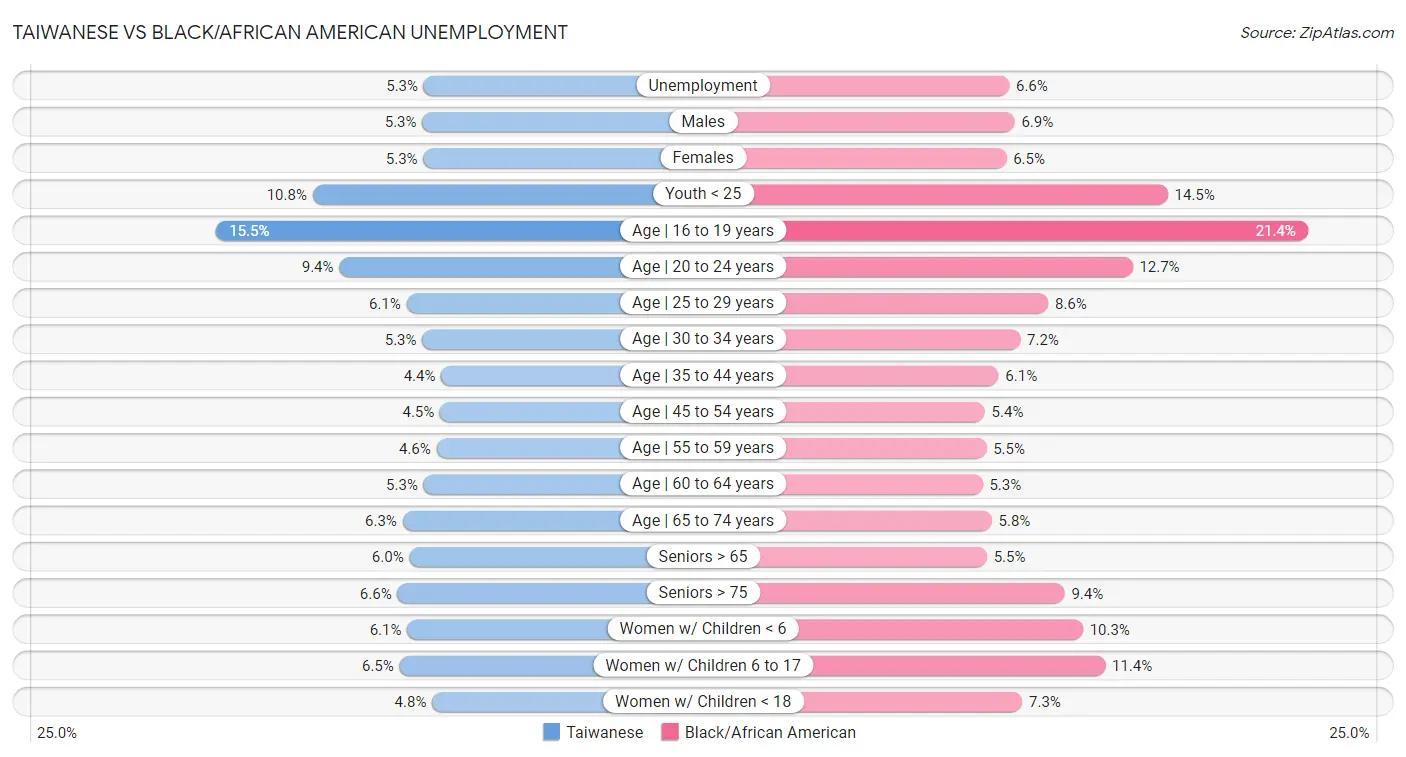
| Unemployment Metric | Taiwanese | Black/African American |
| Unemployment | Average 5.3% | Tragic 6.6% |
| Males | Fair 5.3% | Tragic 6.9% |
| Females | Average 5.3% | Tragic 6.5% |
| Youth < 25 | Exceptional 10.8% | Tragic 14.5% |
| Age | 16 to 19 years | Exceptional 15.5% | Tragic 21.4% |
| Age | 20 to 24 years | Exceptional 9.4% | Tragic 12.7% |
| Age | 25 to 29 years | Exceptional 6.1% | Tragic 8.6% |
| Age | 30 to 34 years | Good 5.3% | Tragic 7.2% |
| Age | 35 to 44 years | Exceptional 4.4% | Tragic 6.1% |
| Age | 45 to 54 years | Good 4.5% | Tragic 5.4% |
| Age | 55 to 59 years | Exceptional 4.6% | Tragic 5.5% |
| Age | 60 to 64 years | Tragic 5.3% | Tragic 5.3% |
| Age | 65 to 74 years | Tragic 6.3% | Tragic 5.8% |
| Seniors > 65 | Tragic 6.0% | Tragic 5.5% |
| Seniors > 75 | Exceptional 6.6% | Tragic 9.4% |
| Women w/ Children < 6 | Exceptional 6.1% | Tragic 10.3% |
| Women w/ Children 6 to 17 | Exceptional 6.5% | Tragic 11.4% |
| Women w/ Children < 18 | Exceptional 4.8% | Tragic 7.3% |
Taiwanese vs Black/African American Labor Participation
When considering labor participation, the most significant differences between Taiwanese and Black/African American communities in the United States are seen in in labor force | age 16-19 (33.8% compared to 36.5%, a difference of 7.8%), in labor force | age 45-54 (83.4% compared to 79.3%, a difference of 5.1%), and in labor force | age 20-64 (80.2% compared to 76.8%, a difference of 4.5%). Conversely, both communities are more comparable in terms of in labor force | age 20-24 (74.7% compared to 73.9%, a difference of 1.2%), in labor force | age 30-34 (84.6% compared to 82.8%, a difference of 2.1%), and in labor force | age 25-29 (85.4% compared to 82.6%, a difference of 3.5%).

| Labor Participation Metric | Taiwanese | Black/African American |
| In Labor Force | Age > 16 | Exceptional 66.2% | Tragic 63.4% |
| In Labor Force | Age 20-64 | Exceptional 80.2% | Tragic 76.8% |
| In Labor Force | Age 16-19 | Tragic 33.8% | Average 36.5% |
| In Labor Force | Age 20-24 | Fair 74.7% | Tragic 73.9% |
| In Labor Force | Age 25-29 | Exceptional 85.4% | Tragic 82.6% |
| In Labor Force | Age 30-34 | Fair 84.6% | Tragic 82.8% |
| In Labor Force | Age 35-44 | Exceptional 85.1% | Tragic 82.2% |
| In Labor Force | Age 45-54 | Exceptional 83.4% | Tragic 79.3% |
Taiwanese vs Black/African American Family Structure
When considering family structure, the most significant differences between Taiwanese and Black/African American communities in the United States are seen in single mother households (5.8% compared to 9.0%, a difference of 56.1%), births to unmarried women (29.0% compared to 44.3%, a difference of 52.8%), and married-couple households (45.9% compared to 38.5%, a difference of 19.3%). Conversely, both communities are more comparable in terms of family households with children (26.7% compared to 26.5%, a difference of 1.1%), average family size (3.23 compared to 3.27, a difference of 1.3%), and family households (63.3% compared to 61.5%, a difference of 3.0%).

| Family Structure Metric | Taiwanese | Black/African American |
| Family Households | Tragic 63.3% | Tragic 61.5% |
| Family Households with Children | Tragic 26.7% | Tragic 26.5% |
| Married-couple Households | Fair 45.9% | Tragic 38.5% |
| Average Family Size | Average 3.23 | Exceptional 3.27 |
| Single Father Households | Exceptional 2.2% | Tragic 2.4% |
| Single Mother Households | Exceptional 5.8% | Tragic 9.0% |
| Currently Married | Poor 45.8% | Tragic 39.6% |
| Divorced or Separated | Exceptional 11.5% | Tragic 13.6% |
| Births to Unmarried Women | Exceptional 29.0% | Tragic 44.3% |
Taiwanese vs Black/African American Vehicle Availability
When considering vehicle availability, the most significant differences between Taiwanese and Black/African American communities in the United States are seen in 4 or more vehicles in household (7.0% compared to 5.5%, a difference of 27.8%), 3 or more vehicles in household (20.0% compared to 17.3%, a difference of 15.5%), and 2 or more vehicles in household (53.9% compared to 50.9%, a difference of 5.9%). Conversely, both communities are more comparable in terms of 1 or more vehicles in household (88.4% compared to 88.2%, a difference of 0.26%), no vehicles in household (11.7% compared to 11.9%, a difference of 1.7%), and 2 or more vehicles in household (53.9% compared to 50.9%, a difference of 5.9%).

| Vehicle Availability Metric | Taiwanese | Black/African American |
| No Vehicles Available | Tragic 11.7% | Tragic 11.9% |
| 1+ Vehicles Available | Tragic 88.4% | Tragic 88.2% |
| 2+ Vehicles Available | Tragic 53.9% | Tragic 50.9% |
| 3+ Vehicles Available | Excellent 20.0% | Tragic 17.3% |
| 4+ Vehicles Available | Exceptional 7.0% | Tragic 5.5% |
Taiwanese vs Black/African American Education Level
When considering education level, the most significant differences between Taiwanese and Black/African American communities in the United States are seen in professional degree (5.0% compared to 3.4%, a difference of 46.3%), doctorate degree (2.1% compared to 1.4%, a difference of 43.2%), and master's degree (16.1% compared to 12.1%, a difference of 33.3%). Conversely, both communities are more comparable in terms of 11th grade (91.3% compared to 91.4%, a difference of 0.060%), nursery school (97.6% compared to 97.9%, a difference of 0.36%), and kindergarten (97.5% compared to 97.9%, a difference of 0.36%).
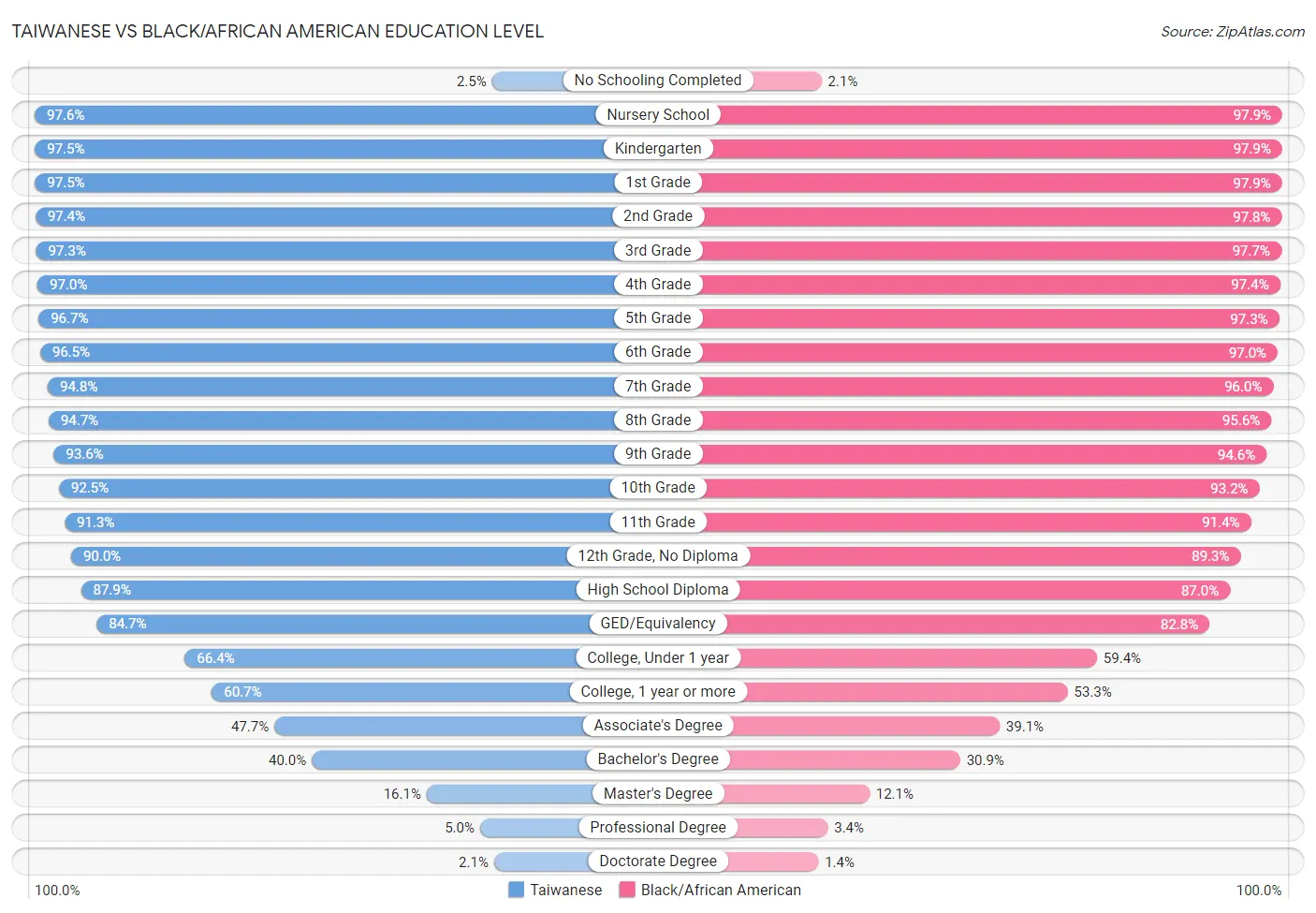
| Education Level Metric | Taiwanese | Black/African American |
| No Schooling Completed | Tragic 2.5% | Average 2.1% |
| Nursery School | Tragic 97.6% | Fair 97.9% |
| Kindergarten | Tragic 97.5% | Fair 97.9% |
| 1st Grade | Tragic 97.5% | Fair 97.9% |
| 2nd Grade | Tragic 97.4% | Fair 97.8% |
| 3rd Grade | Tragic 97.3% | Fair 97.7% |
| 4th Grade | Tragic 97.0% | Fair 97.4% |
| 5th Grade | Tragic 96.7% | Fair 97.3% |
| 6th Grade | Tragic 96.5% | Fair 97.0% |
| 7th Grade | Tragic 94.8% | Average 96.0% |
| 8th Grade | Tragic 94.7% | Fair 95.6% |
| 9th Grade | Tragic 93.6% | Fair 94.6% |
| 10th Grade | Tragic 92.5% | Tragic 93.2% |
| 11th Grade | Tragic 91.3% | Tragic 91.4% |
| 12th Grade, No Diploma | Tragic 90.0% | Tragic 89.3% |
| High School Diploma | Tragic 87.9% | Tragic 87.0% |
| GED/Equivalency | Tragic 84.7% | Tragic 82.8% |
| College, Under 1 year | Good 66.4% | Tragic 59.4% |
| College, 1 year or more | Excellent 60.7% | Tragic 53.3% |
| Associate's Degree | Excellent 47.7% | Tragic 39.1% |
| Bachelor's Degree | Exceptional 40.0% | Tragic 30.9% |
| Master's Degree | Exceptional 16.1% | Tragic 12.1% |
| Professional Degree | Exceptional 5.0% | Tragic 3.4% |
| Doctorate Degree | Exceptional 2.1% | Tragic 1.4% |
Taiwanese vs Black/African American Disability
When considering disability, the most significant differences between Taiwanese and Black/African American communities in the United States are seen in disability age 35 to 64 (9.8% compared to 14.7%, a difference of 49.4%), vision disability (1.9% compared to 2.8%, a difference of 44.6%), and disability age 5 to 17 (4.9% compared to 6.8%, a difference of 37.3%). Conversely, both communities are more comparable in terms of disability age over 75 (48.2% compared to 49.5%, a difference of 2.8%), cognitive disability (17.6% compared to 19.0%, a difference of 8.3%), and hearing disability (2.8% compared to 3.0%, a difference of 8.9%).
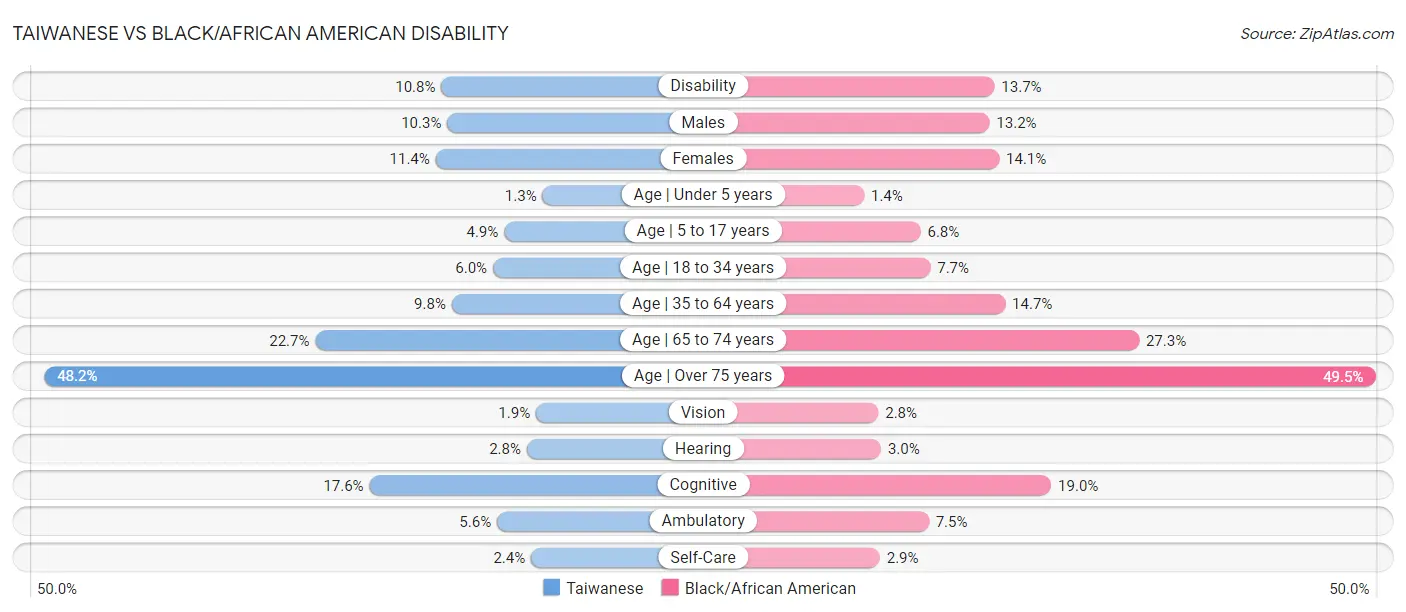
| Disability Metric | Taiwanese | Black/African American |
| Disability | Exceptional 10.8% | Tragic 13.7% |
| Males | Exceptional 10.3% | Tragic 13.2% |
| Females | Exceptional 11.4% | Tragic 14.1% |
| Age | Under 5 years | Tragic 1.3% | Tragic 1.4% |
| Age | 5 to 17 years | Exceptional 4.9% | Tragic 6.8% |
| Age | 18 to 34 years | Exceptional 6.0% | Tragic 7.7% |
| Age | 35 to 64 years | Exceptional 9.8% | Tragic 14.7% |
| Age | 65 to 74 years | Excellent 22.7% | Tragic 27.3% |
| Age | Over 75 years | Tragic 48.2% | Tragic 49.5% |
| Vision | Exceptional 1.9% | Tragic 2.8% |
| Hearing | Exceptional 2.8% | Fair 3.0% |
| Cognitive | Tragic 17.6% | Tragic 19.0% |
| Ambulatory | Exceptional 5.6% | Tragic 7.5% |
| Self-Care | Exceptional 2.4% | Tragic 2.9% |